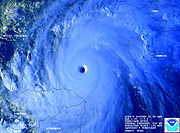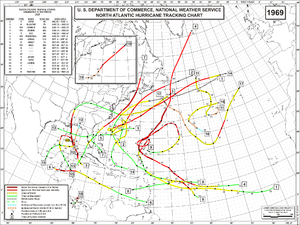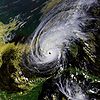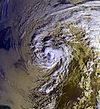- Portal:Tropical cyclones
-
- Wikipedia portals:
- Culture
- Geography
- Health
- History
- Mathematics
- Natural sciences
- People
- Philosophy
- Religion
- Society
- Technology
editTropical cyclones Portal
A tropical cyclone is a storm system characterized by a large low-pressure center and numerous thunderstorms that produce strong winds and heavy rain. Tropical cyclones feed on heat released when moist air rises, resulting in condensation of water vapor contained in the moist air. They are fueled by a different heat mechanism than other cyclonic windstorms such as nor'easters, European windstorms, and polar lows, leading to their classification as "warm core" storm systems. Tropical cyclones originate in the doldrums near the equator, about 10° away from it.
The term "tropical" refers to both the geographic origin of these systems, which form almost exclusively in tropical regions of the globe, and their formation in maritime tropical air masses. The term "cyclone" refers to such storms' cyclonic nature, with counterclockwise rotation in the Northern Hemisphere and clockwise rotation in the Southern Hemisphere. Depending on its location and strength, a tropical cyclone is referred to by names such as hurricane, typhoon, tropical storm, cyclonic storm, tropical depression, and simply cyclone.
- Pictured: Cyclone Gafilo
Purge cache to show recent changes
editSelected article
Hurricane Mitch was one of the most powerful hurricanes ever observed, with maximum sustained winds of 180 mph (290 km/h). The storm was the thirteenth tropical storm, ninth hurricane, and third major hurricane of the 1998 Atlantic hurricane season. At the time, Mitch was the strongest hurricane ever observed in the Atlantic Ocean in the month of October, though it has since been surpassed by Hurricane Wilma of the 2005 season. Mitch formed in the western Caribbean Sea, eventually reaching Category 5 status on the Saffir-Simpson Hurricane Scale. It remained nearly stationary over water for several days, and eventually weakened, striking Honduras as a minimal hurricane.
Though Mitch weakened before striking land, it drifted just off the coast of Central America from October 29 to November 3, dropping historic amounts of rainfall, with unofficial reports of up to 75 inches (1,900 mm). Deaths due to catastrophic flooding made it the second deadliest Atlantic hurricane in history; nearly 11,000 people were killed with over 8,000 left missing by the end of 1998. The flooding caused extreme damage, amounting to around $7 billion (2005 USD), though exact totals will likely never be known.
Recently featured: Hurricane Nora (1997) – Hurricane Claudette (2003) – List of Category 5 Atlantic hurricanes – Browse
editSelected picture
Season track map of the 1969 Atlantic hurricane season, which began in July with the formation of Tropical Storm Ana. The season was among the most active on record, and included the catastrophic Hurricane Camille
editWikiProjects
WikiProject Tropical cyclones is the central point of coordination for Wikipedia's coverage of tropical cyclones. Feel free to help!
WikiProject Meteorology is the main center point of coordination for Wikipedia's coverage of meteorology in general.
editCategories
editRelated Portals
editActive tropical cyclones
North Atlantic (2011)
- No active systems.
East/Central Pacific (2011)
- Tropical Depression Thirteen-E
Northwest Pacific (2011)
- No active systems.
North Indian Ocean (2011)
- No active systems
South-West Indian Ocean (2011–2012)
- No active systems.
Australian region (2011–2012)
- No active systems.
South Pacific (2011–2012)
- No active systems.
editDid you know...
- ... that RSMC Nadi only started to assign the letter F to disturbances in their area of responsibility at the start of the 1998-99 South Pacific cyclone season?
- ... that Tropical Storm Hazel in 1965 was a deadly Pacific tropical storm only 11 years after the deadly Hurricane Hazel in the Atlantic?
- ... that Hurricane Olivia was named when it was a depression?
- ... that Hurricane Irene–Olivia was the first recorded tropical cyclone that moved into the eastern Pacific Ocean from the Atlantic basin?
editTropical cyclone anniversaries
- November 22, 1981 - Typhoon Irma (pictured) reached its peak with winds of 250 km/h (155 mph]) in the Philippine Sea as it approached its landfall in the northern Philippines. Irma caused over 200 fatalities on Luzon.
- November 21, 1992 - Typhoon Gay (pictured) reached its peak strength, with winds of 300 km/h (185 mph) in the open Pacific.
- November 20, 1985 - Hurricane Kate (pictured) reached Category 3 strength in the Gulf of Mexico, becoming the latest major hurricane in the Atlantic basin. It made landfall in Florida the next day.
- November 19, 1979 - The 1977 Andhra Pradesh Cyclone made landfall on the Andhra Pradesh, India coastline with winds of about 210 km/h (130 mph), killing over 10,000 people and destroying 40% of India's food grains.
- November 18, 1994 - Hurricane Gordon (pictured) reached its peak strength as a Category 1 hurricane to the east of North Carolina. Gordon had previously killed over 1000 people in Haiti.
editThings you can do
Here are some tasks you can do:- Requests: Original-content tropical cyclone articles: Typhoon Winnie (1997) and Cyclone Geralda (1994), more
- Copyedit: Hurricane Marco (1996), Hurricane Elida (2002), Effects of Hurricane Dennis in Florida, Criticism of government response to Hurricane Katrina,
- Wikify: Make sure tropical cyclone lists, such as List of Texas hurricanes, have storm articles properly linked
- Cleanup: Hurricane Rita, Hurricane Wilma, Tropical Storm Fay (2002)
- Expand: Indianola Hurricane of 1886, Hurricane Carla, Typhoon Nina (1975), Typhoon Durian
- Stubs: 1931 Belize hurricane, History of tropical cyclone-spawned tornadoes More...
- Update: Hurricane Stan and Tropical Depression Sixteen (2008)
Categories:- Physical science portals
- Tropical cyclones
- Tropical cyclones portal
Wikimedia Foundation. 2010.














